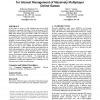165 search results - page 8 / 33 » Procrastination, participation, and performance in online le... |
NOSSDAV
2005
Springer
14 years 1 months ago
2005
Springer
In this paper we propose a fully distributed peer-to-peer (P2P) infrastructure supporting Networked Virtual Environment (NVE) applications, such as massively multiplayer online ga...
CHI
1997
ACM
13 years 12 months ago
1997
ACM
We introduce a framework for supporting crowds of participants in collaborative virtual environments (CVEs). The framework is realised as an extension to our previous spatial mode...
HICSS
2003
IEEE
14 years 1 months ago
2003
IEEE
This paper describes the design and evaluation of COLER, a computer mediated learning environment that includes a software coach to help students collaborate while solving Entity ...
ICPR
2010
IEEE
13 years 5 months ago
2010
IEEE
Detecting abnormal behaviors in crowd scenes is quite important for public security and has been paid more and more attentions. Most previous methods use offline trained model to p...
ICAC
2007
IEEE
14 years 2 months ago
2007
IEEE
— Reactive systems are those that maintain an ongoing interaction with their environment at a speed dictated by the latter. Examples of such systems include web servers, network ...

